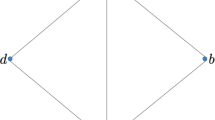Abstract
Branching on forbidden induced subgraphs is a genetic strategy to obtain parameterized algorithms for many edge modification problems. For such a problem in which the graph property is defined by multiple forbidden induced subgraphs, branching process is trivially performed on each subgraph. Thus, the size of the resulting search tree is dominated by the size of the largest forbidden subgraph. In this paper, we present a simple strategy for deriving significantly improved branching rules to deal with multiple forbidden subgraphs by edge modifications. The basic idea hereby is that while constructing branching rules for the largest forbidden subgraph, we sufficiently take into account the structural relationship between it and other forbidden subgraphs. By applying this strategy, we obtain improved parameterized algorithms for edge modification problems for several graph properties such as 3-leaf power, proper interval, threshold and co-trivially perfect graphs.











Similar content being viewed by others
References
Bessy S, Paul C, Perez A (2010) Polynomial kernels for 3-leaf power graph modification problems. Discret Appl Math 158(16):1732–1744
Bessy S, Perez A (2011) Polynomial kernels for proper interval completion and related problems. In: Proceedings of 18th international symposium on fundamentals of computer theory, vol 6914. Lecture Notes in Computer Science, pp 229–239
Brandstäda A, Le VB, Spinrad JP (1999) Graph classes: a survey (monographs on discrete mathematics and applications). SIAM, Philadelphia
Cai L (1996) Fixed-parameter tractability of graph modification problems for hereditary properties. Inf Process Lett 58(4):171–196
Downey R, Fellows M (1999) Parameterized complexity. Springer-Verlag, Berlin
Dom M, Guo J, Hüffner F, Niedermeier R (2006) Error compensation in leaf power problems. Algorithmica 44(4):363–381
Feng Q, Wang J, Chen J (2014) Matching and weighted P2-packing: algorithms and kernels. Theor Comput Sci 522:85–94
Gramm J, Guo J, Hüffner F, Niedermeier R (2004) Automated generation of search tree algorithms for hard graph modification problems. Algorithmica 39(4):321–347
Guo J, Hüffner F, Komusiewicz C, Zhang Y (2008) Improved algorithms for bicluster editing. In: Proceedings of 5th theory and applications of models of computation, vol 4978. Lecture Notes in Computer Science, pp 445–456
Guo J (2007) Problem kernels for NP-complete edge modification problems: split and related graphs. In: Proceedings of 18th international symposium on algorithms and computation, vol 4835. Lecture Notes in Computer Science, pp 915–926
Kaplan H, Shamir R, Tarjan RE (1999) Tractability of parameterized completion problems on chordal, strongly chordal, and proper interval graphs. SIAM J. Comput. 28(5):1906–1922
Liu Y, Wang J, Guo J, Chen J (2012) Complexity and parameterized algorithms for cograph editing. Theor Comput Sci 461:45–54
Nastos J, Gao Y (2010) A novel branching strategy for parameterized graph modification problems. In: Proceedings of 4th annual international conference on combinatorial optimization and applications, vol 6509. Lecture Notes in Computer Science, pp 332–346
Niedermeier R, Rossmanith P (2000) A general method to speed up fixed-parameter tractable algorithms. Inf Process Lett 73:125–129
Sharan R (2002) Graph modification problems and their applications to genomic research. PhD thesis, Tel-Aviv University
Villanger Y (2010a) Proper interval vertex deletion. Presentation in the 5th international symposium on parameterized and exact computation. http://www.lirmm.fr/~paul/ANR/CIRM-TALKS-2010/Villanger-cirm-2010.pdf
Villanger Y (2010b) Proper interval vertex deletion. In: Proceedings of the 5th international symposium on parameterized and exact computation, vol 6478. Lecture Notes in Computer Science, pp 228–238
Wang J, Tan P, Yao J, Feng Q, Chen J (2013) On the minimum link-length rectilinear spanning path problem: complexity and algorithms. IEEE Trans Comput. doi:10.1109/TC.2013.163
Wegner G (1967) Eigenschaften der Nerven homologisch-einfacher Familien im \(R^{n}\). PhD thesis, Universität Göttingen
Author information
Authors and Affiliations
Corresponding author
Additional information
A preliminary version of this paper was presented at the 19th Annual International Computing and Combinatorics Conference (COCOON 2013), June 21–23, 2013, Hangzhou, China. This research was supported in part by the National Natural Science Foundation of China under Grant Nos. 61070224, 61232001, and 61173051, the China Postdoctoral Science Foundation funded project under Grant No. 2012M521551, and the DFG Cluster of Excellence “Multimodal Computing and Interaction (MMCI)”.
Rights and permissions
About this article
Cite this article
Liu, Y., Wang, J., Xu, C. et al. An effective branching strategy based on structural relationship among multiple forbidden induced subgraphs. J Comb Optim 29, 257–275 (2015). https://doi.org/10.1007/s10878-014-9733-1
Published:
Issue Date:
DOI: https://doi.org/10.1007/s10878-014-9733-1




